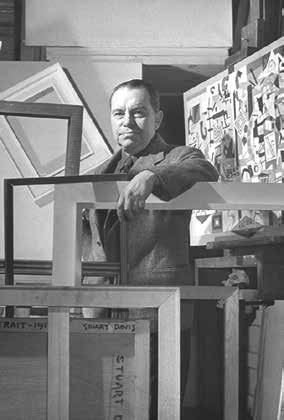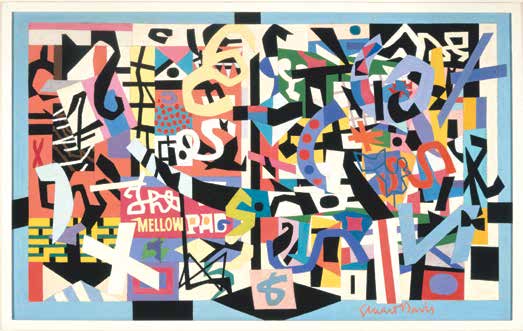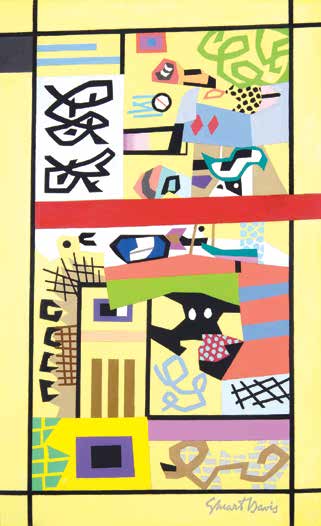 At the de Young, April 1–August 6
At the de Young, April 1–August 6
The Fine Arts Museums of San Francisco are pleased to present Stuart Davis: In Full Swing, the first major exhibition in 20 years dedicated to Davis (1892–1964), a key figure in the development of American Modernism. Approximately 75 works will reveal Davis’s unique ability to assimilate the imagery of popular culture, the aesthetics of advertising, and the rhythms of jazz into colorful works that hum with infectious energy. Loans from the Whitney Museum of American Art, New York’s Museum of Modern Art, the Metropolitan Museum of Art, and the Hirshhorn Museum and Sculpture Garden among others, will allow West Coast audiences the rare opportunity to see career-spanning works by this enterprising modern painter, who ranks with Georgia O’Keeffe and Edward Hopper as among the most important American artists of his generation.
“Stuart Davis was an artist both ahead of his time, and completely immersed in it,” says Max Hollein, director and CEO of the Fine Arts Museums of San Francisco. “His works provided comment on the times and were simultaneously a dominant force in postwar art. The de Young has always believed that artists have a duty to comment and critique our culture and we are pleased to show how one American artist responded to the tumultuous times he lived through.”
Not quite a retrospective, Stuart Davis: In Full Swing takes as its starting point Davis’s breakthrough paintings of commercial products from the early 1920s and concludes with the unfinished canvas left on his easel at his death in 1964—spanning a period of time that ranges from the jazz age to the protest era. The organization of this exhibition is unique, revealing new aspects of Davis’s practice. Related works from different periods of the artist’s career will be installed alongside one another, reflecting Davis’s tendency, beginning in the late 1930s, to appropriate and rework his own earlier compositions; this will be the first major exhibition to do so. The presentation also will include Davis’s kinetic compositions, which evoke the excitement, speed, and turbulence of the age, and continue to feel fresh and resonant today.

“Davis’s work was always ahead of its time,” says Emma Acker, assistant curator of American art for the Fine Arts Museums of San Francisco, “from his appropriation of images from consumer culture and advertising in the 1920s, which predates 1960s Pop art; to his colorful ‘all-over’ abstractions of the early 1940s, which anticipate the ‘action painting’ of the Abstract Expressionists; to the ‘billboard aesthetic’ of his large-scale works from the early 1950s, whose reductive abstraction looks forward to 1960s Color- field painting. He is a pivotal figure in American art who blurred the boundaries between high and low, text and image, and representation and abstraction to create modern art that is lively and accessible, and reflects the world we live in.”
Stuart Davis: In Full Swing is co-organized by Barbara Haskell, curator at the Whitney Museum of American Art in New York, and Harry Cooper, curator and head of modern art at the National Gallery of Art in Washington, D.C. The presentation at the de Young museum, organized by FAMSF’s Acker, will be on view from April 1 through August 6, 2017. Following its presentation at the de Young, the exhibition will travel to the Crystal Bridges Museum of American Art in Bentonville, Arkansas, where it will be on view from September 16, 2017, through January 1, 2018.
Stuart Davis Life and Legacy
Davis began his career at an early age, leaving high school after his freshman year to study art full time with Ashcan School leader Robert Henri in New York City. Five of his watercolors were included in the now-legendary Armory Show of 1913, which introduced Davis to the avant-garde European modernist styles that heavily influenced his subsequent work. His exposure to European Modernism continued during a yearlong sojourn in Paris, where he painted scenes of cafes and street life.
The de Young’s presentation begins in 1921, as Davis emerged from his apprenticeship with European modernist artists and movements and began to develop his mature style. Early works such as Lucky Strike draw their imagery from familiar commercial products and merge the bold, graphic style of advertising with the visual language of Cubism to communicate a distinctly modern—and an unmistakably American— experience. Davis similarly incorporated a Cubism-derived structure of flat, overlapping planes in the works he produced toward the end of the 1920s—including his well-known Egg Beater series of abstract still lifes (1927–28), three of which will be on display, and the vibrant landscapes he made in Paris, New York, and Gloucester, Massachusetts, where, beginning in 1915, he often spent summers.
During the Depression years of the 1930s, Davis was a committed social activist, dedicating much of his time to organizing on behalf of artists’ rights. By the late 1930s, he had increased the scale of his work and embraced an even more abstract language, influenced in part by his work as a muralist; one of the highlights of this section of the exhibition is his New York Mural (1932), which he produced for an exhibition at New York’s Museum of Modern Art. Davis’s abstractions of the 1940s, such as For Internal Use Only (1944–45) and The Mellow Pad (1945–51), feature densely patterned surfaces that anticipate the all-over compositional formats of Abstract Expressionists like Jackson Pollock.
In the works he produced between the end of World War II and his death, Davis abandoned the shallow pictorial space of Cubism in favor of even flatter compositions that reflect the aesthetic of the billboard, as seen in Visa (1951), whose reductive abstraction looks forward to 1960s Color-field painting.
A lifelong jazz enthusiast, Davis stated that jazz was the “great American art expression,” with “the same quality of art that [he] found in the best modern painting.” Davis’s working method of appropriating and reworking his own earlier compositions shares with that musical genre the concept of variations on a theme, and similarly conveys a uniquely modern sense of dynamism and vibrancy.
Related Programming
Saturday, April 1, join the de Young for an opening day celebration including a concert by Jazz of the Harlem Renaissance, art making, and a lecture by Nate Sloan on “Thriving on a Riff: Jazz and the Art of Stuart Davis.”
Sundays, May 7–21, there will be jazz concerts in the museum atrium.
A guest lecture by Barbara Haskell, curator at the Whitney Museum of American Art in New York, will take place on Sunday, May 21, and will be followed by a jazz concert.
On Friday, June 16, exhibition curator Emma Acker, assistant curator of American art for the Fine Arts Museums, will give a lecture on the exhibit.
For more information: deyoungmuseum.org/stuart-davis
Recent Comments